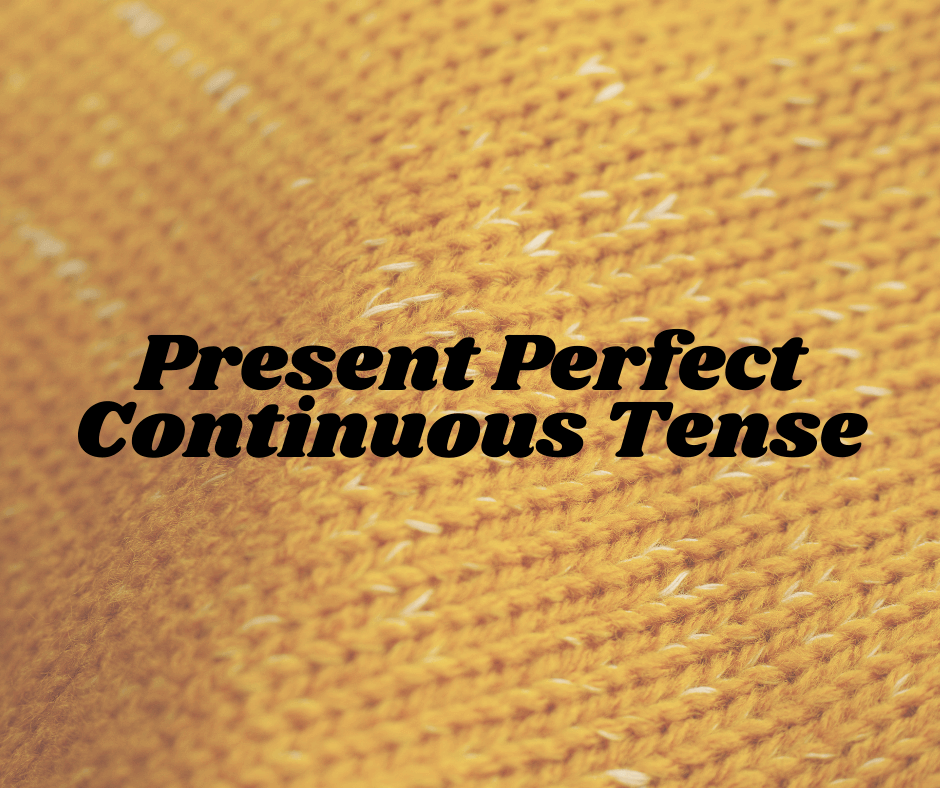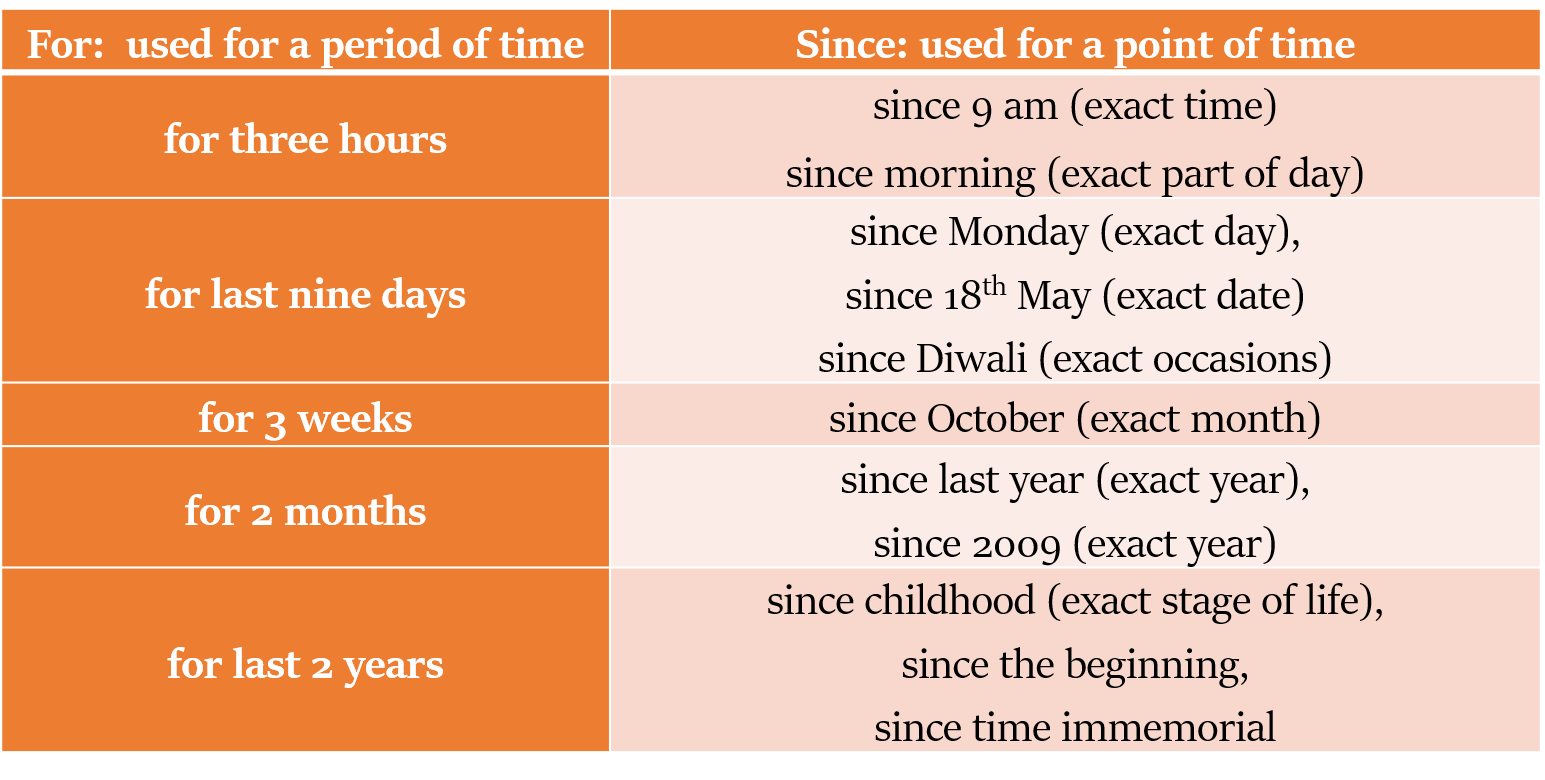Present Perfect Continuous Tense की अवधारणा (Concept of Present Perfect Continuous Tense)

Overview
इस लेख में हम अंग्रेजी के एक महत्त्वपूर्ण अध्याय के बारे में जानेंगे - Present Perfect Continuous Tense की अवधारणा, in Hindi (हिंदी में)
 नोट
नोटइस अध्याय से सम्बंधित, अन्य विषयों के बारे में जानने के लिए आप हमारे निम्नलिखित लेख पढ़ सकते हैं:
इस लेख में, हम Present Perfect Continuous Tense (प्रेजेंट परफेक्ट कंटीन्यूअस टेंस) की अवधारणा, इसके विभिन्न उपयोगों और इस tense का उपयोग करके बनाई जाने वाली विभिन्न वाक्य संरचनाओं के बारे में अध्ययन करने जा रहे हैं।
Present Perfect Continuous Tense के उपयोग
उपयोग 1
हम किसी ऐसी स्थिति (situation) या गतिविधि (activity) के बारे में बात करने के लिए Present Perfect Continuous tense का उपयोग करते हैं, जो अतीत में शुरू हुई थी और अब तक प्रगति पर है (यह दिखाने के लिए कि कोई चीज़ कितने समय से चल रही है)।
कभी-कभी हम present perfect continuous के साथ कुछ समय-अवधि दर्शाने वाले शब्द भी उपयोग करते हैं, जैसे की since और for
He has been living in Melbourne for over a decade now. ('for' के प्रयोग पर ध्यान दें)
This company has been running since 1983. ('since' के प्रयोग पर ध्यान दें)
किसी भी समय-अवधि के संदर्भ के बिना, present perfect continuous हाल की स्थिति या गतिविधि को संदर्भित करता है और इसके वर्तमान परिणामों पर ध्यान केंद्रित करता है:
It has been raining. (or It’s been raining) (यानी अभी भी बारिश हो रही है)
You look exhausted. Yes, I have been working in the lab. (यानी मैंने अभी काम करना बंद किया है)
उपयोग 2
हम Present Perfect Continuous tense का उपयोग एक ऐसी गतिविधि के लिए करते हैं, जो अभी भी चल रही है या हाल ही में रुकी है (यानी अब के समय के साथ एक संबंध है)।
I have been talking to the lawyers about this defamation case. (बात करने का काम अभी भी चल रहा है)
Have you been jogging? (हाल ही में रुका हूँ)
 नोट
नोटहम Present Perfect Continuous tense का उपयोग उन स्थितियों या कार्यों के लिए नहीं करते हैं, जो अब से पहले किसी विशेष बिंदु पर समाप्त हो गए हैं (यानी वे जो हाल ही में समाप्त नहीं हुए हैं)।
I have been reading until midnight last night. (गलत – Present Perfect Continuous tense का गलत उपयोग)
I was reading until midnight last night. (सही)
He has been putting off the decision for long, but eventually he resigned. (गलत – Present Perfect Continuous tense का गलत उपयोग)
He put off the decision for long, but eventually he resigned. (सही)
उपयोग 3
हम किसी समय की अवधि में दोहराए गए कार्यों के लिए Present Perfect Continuous tense का उपयोग करते हैं।
Pakistan violates LOC again and again. It has been going on there for years.
उपयोग 4
जब हम ‘How long...?’ के साथ प्रश्न पूछते हैं, तो हम Present Perfect Continuous tense का उपयोग करते हैं।
How long have you been waiting for me?
Present Perfect Continuous tense की विभिन्न वाक्य संरचनाएं
हम Present Perfect Continuous tense में निम्नलिखित सहायक क्रियाओं (helping verbs) का उपयोग करते हैं (subject के पुरुष और संख्या के आधार पर):
tenses
घोषणात्मक वाक्यों की संरचना (Structure of Declarative sentences)
सकारात्मक घोषणात्मक वाक्य (Affirmative Declarative Sentences)
पैटर्न: Subject + has/have + been + + Object + for/since + time
Aanya has been playing badminton for a long time.
They have been playing badminton for a long time.
नकारात्मक घोषणात्मक वाक्य (Negative Declarative Sentences)
पैटर्न: Subject + has/have + not been + + Object + for/since + time
Aanya has not been playing badminton for a long time.
They have not been playing badminton for a long time.
प्रश्नवाचक वाक्यों की संरचना (Structure of Interrogative sentences)
सकारात्मक प्रश्नवाचक वाक्य (Affirmative Interrogative Sentences)
पैटर्न 1: Has/Have + Subject + been + + Object + for/since + time?
Has Aanya been playing badminton for a long time?
Have they been playing badminton for a long time?
पैटर्न 2: Wh. family + has/have + Subject + been + + Object + for/since + time?
Where has Aanya been playing badminton since last year?
Where have they been playing badminton since last year?
नकारात्मक प्रश्नवाचक वाक्य (Negative Interrogative Sentences)
पैटर्न 1: Has/Have + Subject + not + been + + Object + for/since + time?
Has Aanya not been playing badminton since 2019?
Have they not been playing badminton since 2019?
पैटर्न 2: Wh. family + has/have + Subject + not + been + + Object + for/since + time?
Why has Aanya not been playing badminton since 2019?
Why have they not been playing badminton since 2019?
for और since का उपयोग
'For' का प्रयोग किसी समय-अवधि (period of time) के लिए किया जाता है, जबकि 'Since' का प्रयोग समय के किसी बिंदु (point of time) के लिए किया जाता है।
tenses
एक उदाहरण पर विचार करें:
I have been playing since an hour. (गलत)
I have been playing for an hour. (सही)
यहां समय की अवधि (period of time) दी गई है (एक घंटा), इसलिए हम 'for' का उपयोग करेंगे न कि 'since' का।

अतिरिक्त पुस्तकें और उपकरण
यदि आप किताबों के माध्यम से सीखना पसंद करते हैं, या संदर्भ उद्देश्यों के लिए कुछ अच्छी अंग्रेज़ी व्याकरण किताबें चाहते हैं, तो आप हमारा यह लेख पढ़ सकते हैं|